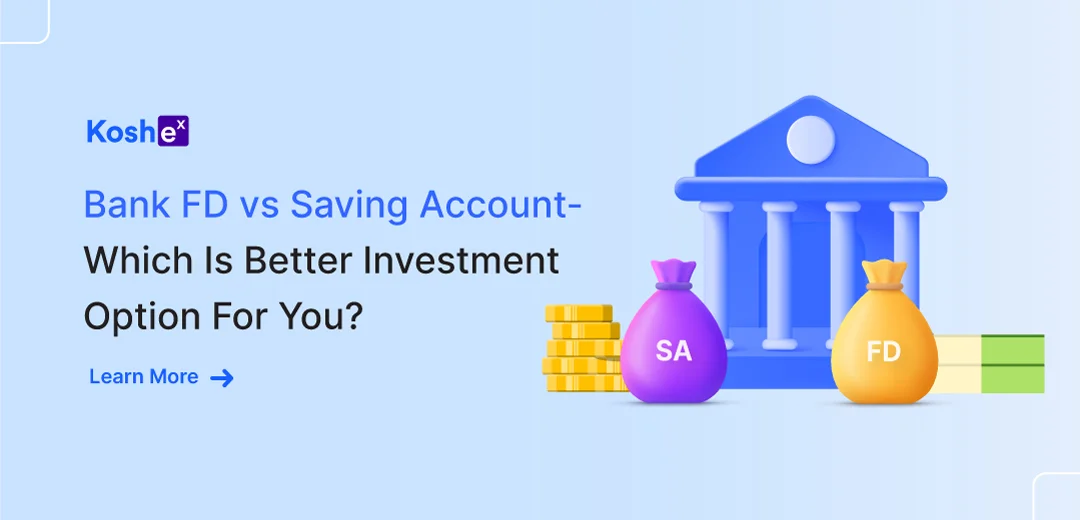Saving money through Savings Bank Accounts and Fixed Deposits (FDs) is a popular tradition in India. It’s been passed down from previous generations and proves helpful in handling emergencies, which are becoming more common.
Most people either save their money in a savings bank account or invest in other options like FDs, which provide guaranteed returns and ensure wealth safety.
While saving in a Savings Bank Account may be a good option for immediate emergencies, relying solely on it is not ideal due to inflation, which affects the value of money. Investing in an instrument that saves money and earns a reasonable interest rate becomes crucial as inflation rises.
The critical difference between savings accounts and FDs is the interest rates. FDs offer higher interest rates than savings accounts. But which option is better? Let’s explore this further.
Features of Savings Account
When an individual enters the savings and investments landscape, the first step is opening a savings account in a bank of his choice. The features of a savings account are as follows:
Parking of funds: The savings account is a very safe place to park our excess funds and create an emergency fund.
Rate of interest: The rate of interest on savings accounts ranges from 2.70% to 6.00%, depending on the bank and account balance and savings account type.
Ceiling: No ceiling on the amount that can be deposited or withdrawn. Savings bank accounts are very flexible and have the least restrictions on operating them.
Insurance: In India, savings accounts are insured up to Rs 5 lakhs.
Minimum balance requirement: Depending on the bank (whether public, private, or co-operative) and the type of savings account, the minimum amount that needs to be maintained ranges from nil to Rs 10,000 or even more in some cases.
Transaction limits: For savings accounts, there are certain limits on the number of deposits, withdrawals, and non-financial transactions that can take place for free in a month. Also, there are limits on the amount that can be deposited in one go. These transaction limits depend on the type of savings account you have and the rules laid down by RBI.
Access to other facilities: Opening a savings account also provides facilities like access to internet / net banking, debit card, facility of creating a standing-instructions to pay bills regularly, and access to the bank’s ATM facility.
Cross-product benefits: Some banks offer unique benefits to savings account holders, like providing other banking facilities; for example, if you have a savings account in a particular bank, you might get to open a Demat account at a minimal annual maintenance charge as compared to people who have a Demat account in that bank.
Bank charges: Some banks charge nominal fees for providing net banking or phone banking facilities, like charges for SMS alerts or for not maintaining a minimum balance, depending on the type of savings account.
Features of Bank FDs
Bank FDs are considered one of the safest investment options with a guarantee of returns, especially if FD is opened with a nationalized bank. They are easy to open and offer flexible tenures. Other features include:
Secure investment: FDs offer a fixed rate of return and are safe. That means, even if the rates fall, one gets the same rate of return at the time of opening the fixed deposit.
Flexible tenure: A FD can be opened for a flexible duration ranging from 7 days to 10 years.
Rate of interest: The rate of interest ranges from 6.5% to 7.75%, depending on the bank, the duration of the fixed deposits, and the amount of money invested. FDs provide a higher rate of interest as compared to a savings account.
Loan against FD: Most banks also offer a loan against FD, wherein the loan amount equals 80% to 90% of the fixed deposit amount, depending on the bank and money invested in the FD.
Tax Savings: Banks also allow to open up a tax savings FD which provides a tax deduction of Rs 1,50,000 under Section 80C of The Income Tax Act, 1961, with a compulsory lock-in tenure of 5 years.
Easy renewals: One can easily renew bank FDs after the tenure ends by instructing the bank.
Sweep-in and sweep-out facility: Some banks also offer a sweep-in and sweep-out facility, where an FD is created automatically from the savings account. Depending on the instructions of the savings account holder, when a certain amount of balance is reflected in the savings account, an extra amount is transferred, and a bank FD is created automatically.
For example, an individual has a savings account opened with a sweep-in and sweep-out facility activated. Per their instructions, when the savings account balance reaches Rs 2,50,000, an amount of Rs 1,00,000 should automatically get transferred to create an FD of Rs 1,00,000.
And when the amount in the savings account reaches the minimum balance required, the FD of Rs 1,00,000 is again automatically transferred to the savings account with the applicable interest amount accrued as per the tenure of the FD.
This facility helps earn a higher interest rate from extra money lying idle in a savings account.
Multiple FD accounts: One can also open various bank FDs in the same bank if more amount is needed.
Withdrawals: The investment amount is locked in during the tenure of FDs, and the penalty is charged in case of emergency pre-mature withdrawal.
So, savings account or Bank FD, which one is better?
To choose, one has to consider the funds required for an emergency, the amount that can be set aside for a certain period to earn a specific rate of return, and the frequency with which funds are required.
Bank FDs provide higher returns than savings accounts and prove to be a great investment instrument compared to a regular savings account. Also, for senior citizens, the interest rate in FDs is even higher than average FD rates.
In a nutshell, FDs provide a higher interest rate, are more suitable for achieving one’s financial goals and wealth creation, and can be a conscious effort to invest wisely and save more.
To make your financial journey easy and simple, unlock the power of investing by signing up for Koshex.
Frequently Asked Questions
What is the purpose of savings accounts and FDs?
The savings account mainly serves to park excess funds and create an emergency fund. The primary purpose of an FD is to create wealth as it provides a higher interest rate than a savings account.
Can I withdraw money from FD anytime?
Withdrawing money from an FD account is not allowed before the completion of its tenure. However, money from an FD account can be withdrawn in an emergency, and some banks charge a certain penalty.









Leave a Comment